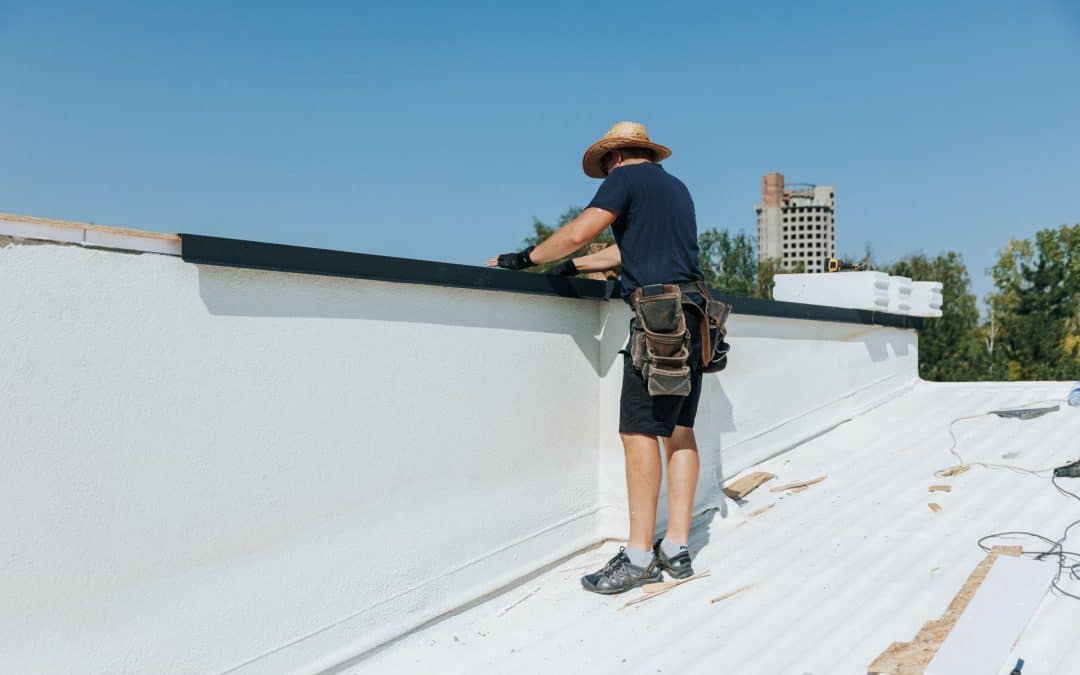When exploring roofing options, it’s crucial to consider a material’s versatility and adaptability to different building types. TPO (Thermoplastic Polyolefin) roofing systems have surged in popularity due to their strong performance in various architectural contexts. Whether it’s shielding a sprawling commercial complex or covering a cozy suburban home, TPO roofing offers a reliable and efficient solution.
What stands out about TPO roofing is its unique combination of durability, cost-effectiveness, and environmental friendliness. These qualities make it a favored choice among builders and homeowners alike. It handles extreme weather conditions with grace, provides excellent insulation, and contributes to energy savings by reflecting sunlight.
In this discussion, we will delve into the world of TPO roofing, exploring its suitability for different kinds of buildings. We believe it’s crucial for our clients to understand why TPO might just be the roofing solution they’re looking for. Let’s uncover the core features that make TPO roofing a versatile and wise choice for both commercial and residential properties.
What Is TPO Roofing and Why Choose It?
TPO, or Thermoplastic Polyolefin, is a type of roofing material that many people are choosing because it’s really good at protecting buildings. This material is made in a way that helps it resist a lot of common problems like UV rays from the sun, tears, and even punctures. One of the big things about TPO roofing is that it’s really good for different kinds of weather. It can handle lots of sun, strong winds, and heavy rain. This makes it a trustworthy choice for places with all kinds of weather.
Another great reason to choose TPO roofing is that it helps keep buildings cooler. The material reflects sunlight instead of absorbing it. This means the inside of the building doesn’t get too hot, which can help save money on air conditioning. Because of these benefits, TPO roofing is a smart choice for anyone who wants a roof that lasts a long time, keeps the building safe, and helps save on energy costs.
TPO Roofing for Commercial Buildings: A Perfect Match
When it comes to commercial buildings, like stores, offices, or factories, TPO roofing is a fantastic choice. One big reason why it’s great for bigger buildings is that it’s made of wide sheets. These wide sheets help cover large roofs quickly and reduce the chances of leaks. Every piece of the material overlaps closely with the next, sealed tight to stop water from getting in. This is super important for large roofs where water leaks could cause big problems.
Commercial buildings often have a lot of equipment on the roof, like air conditioning units or exhaust vents. TPO roofing is strong and can be walked on, which is good for when people need to go up there for maintenance or repairs. Also, this material doesn’t require a lot of upkeep, which is a big plus for business owners who need a low-maintenance option. In short, TPO roofing offers durability, efficiency, and ease of maintenance, making it an ideal match for commercial properties.
Residential Applications: TPO Roofing in Home Construction
Though TPO roofing is often highlighted for its commercial applications, its benefits are equally compelling when used in residential settings. Homeowners looking for a durable and efficient roofing solution find TPO to be an appealing option. Its strong resistance to the elements ensures that it can handle the sometimes harsh weather conditions that might damage other types of roofing materials. Whether dealing with heavy rain, strong winds, or harsh sun, TPO stands up to the challenge, ensuring that the home remains safe and dry.
Beyond its durability, TPO roofing is also loved for its energy efficiency. Its reflective surface helps keep homes cooler in the warm months, reducing the need for air conditioning and lowering energy bills. This makes TPO a smart choice for homeowners who are conscious of their budget and their environmental impact. Moreover, TPO’s lightweight nature means it can be installed on various homes without additional structural support, which can be a major advantage in residential construction.
TPO Roofing Systems and Sustainability Features
One of the foremost reasons to opt for TPO roofing is its strong environmental profile. As a sustainable roofing choice, TPO offers numerous green benefits that are important in today’s eco-conscious market. Its highly reflective surface significantly diminishes heat island effects, a common problem in urban areas where built environments tend to increase temperatures. By reflecting sunlight, TPO reduces the need for artificial cooling, thereby saving energy and decreasing greenhouse gas emissions.
Furthermore, TPO roofing materials are 100% recyclable at the end of their life cycle. This means they don’t have to contribute to landfill waste, unlike many traditional roofing materials. Coupled with their long lifespan, this makes TPO a choice that benefits the environment both now and in the future. For businesses and homeowners alike, investing in a TPO roof means making a commitment to a sustainable future by choosing a product that minimizes environmental impact while providing exceptional performance and value.
Conclusion
At Mike Huddleston Roofing Systems, we recognize the importance of providing roofing solutions that meet the diverse needs of our clients while also adhering to our high standards of quality and sustainability. TPO roofing systems represent just such a solution. Offering unmatched versatility, durability, and environmental benefits, TPO is suitable for a wide range of building types and applications. Whether you’re looking to outfit a commercial property or a private residence, TPO roofing systems offer a compelling array of advantages that make them a smart choice for any project.
Ready to explore how TPO roofing can benefit your property? Contact us today to find out more about our roofing services and how we can help you make the best choice for your needs. Let Mike Huddleston Roofing Systems be your partner in your next roofing project, ensuring durability, efficiency, and sustainability.

